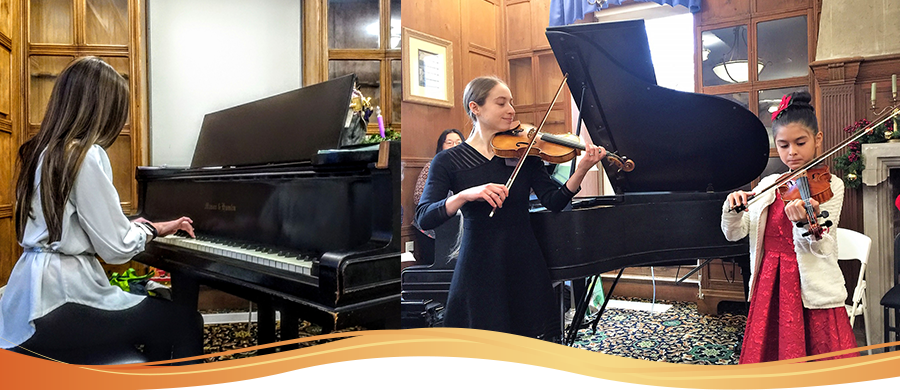
Online
Music for the Community
If you're interested in a particular category, you can sort performances by student age, instrument, singalong music, composer and so on - click on the orange tags under the text. We hope you and your family will enjoy watching our students share their music!
To have each week's videos and accompanying info sent to your inbox*, please subscribe via the orange button.
*Videos are delivered twice weekly; you can unsubscribe at any time, and we will never share or sell your info.
Subscribe to this Page
Displaying items by tag: Students age 8 to 9
Day 57 - Chant Arabe by Chwatal
Pianist age 8 plays "Chant Arabe" by F. X. Chwatal
Franz Xaver Chwatal (1808 – 1879) was a Bohemian pianist, composer and music teacher. He was the son of an organ builder, who gave him piano lessons as a child. He wrote many pieces of lighter popular music such as this one.
Like so many other pieces we’ve featured, this one is in A – B1/B2 – A form, giving it a pleasing symmetry. In the A section, you can hear the pianist’s left hand playing one chord that’s repeated over and over, like the unchanging, rhythmic plod of the camels across the desert.
There are several singalong options here – try them all, and let us know in the comments which one you like best!
(A) In far-off desert lands, where the oasis stands, camels in caravans trail across burning sands.
(B1) Riders in flowing turbans sit / high atop the swaying animals;
(B2) Bells tinkling, jingling, sweetly ring / out across the desert air and gently tell us...
(A) In far-off desert lands, where the oasis stands, camels in caravans trail across burning sands.
~ or ~
(A) I am thirsty and hot; I am thirsty and hot; I am thirsty and hot; I am thirsty and hot!
(B1) I sure would like some lemonade; / Mother may I? Honey, yes you may. (B2) I sure would like some lemonade; / will you get some for me now? Just wait a minute....
(A) I sure like lemonade; I sure like lemonade; I sure like lemonade, when I’m thirsty and hot.
~ or ~
(A) Oh, it’s hot, very hot! Oh, it’s hot, very hot! Oh, it’s hot, very hot! Oh, it’s hot, very hot!
(B1) Softly the camels tread with their / heavy load across the burning sand;
(B2) Under the blazing sun they plod / on and on and on across the endless desert....
(A) Oh, it’s hot, very hot! Oh, it’s hot, very hot! Oh, it’s hot, very hot! Oh, it’s hot, very hot!
Day 51 - The Happy Farmer
Violinist age 8 plays "The Happy Farmer"
German composer and pianist Robert Schumann lived from 1810 to 1856. He was a brilliant pianist and intended to make a career as a perfomer. Unfortunately a hand injury put an end to that idea, so thereafter he focused on composing.
Meanwhile, he had fallen in love with his piano teacher's daughter, Clara Wieck - herself a wonderful pianist - but her father was very opposed to their marriage. Robert eventually won out, though, and married her in 1840 after a court battle.
By 1848 he and Clara had three young daughters (they eventually had eight children, seven of whom survived). He composed a collection of 43 easy piano pieces for them, "Album for the Young", and The Happy Farmer is one of these pieces. As with our other singalong songs, the words reflect the musical structure, which is little unusual here: A1 - A1 - B - A2 - B - A2, with the A section having two different endings. The B section is very short: the farmer (A) barely lets his wife (B) get a word in edgewise before interrupting her again!
Day 47 - Lightly Row
Pianists age 6 and 8 play Lightly Row
Day 46 - Hongroise (Hungarian Dance)
Violinist age 9 plays "Hongroise" by Robert Pracht.
Day 37: Red Parrot, Green Parrot
Violinist age 8 plays "Red Parrot, Green Parrot" by Edwards Huws Jones
Day 34: The Dance of the Spider and the Fly
Pianist age 8 plays "The Dance of the Spider and the Fly" by Donald Waxman
A native of Baltimore, Donald Waxman met his wife Jho at the Peabody Conservatory, and shortly after graduation the couple founded a music school in Nyack, New York. Like our Day 2 composer, Kabalevsky, the Waxmans felt that musical language in the piano methods of the time was dated, and not challenging or interesting enough for 20th century students.
Mr. Waxman says, “ I wanted young students to be working in a language more varied than that of so many piano method books. I wanted students to be playing and hearing music written in a wide variety of intervals, modes and tonal and chromatic combinations that go beyond the extreme limitations of music based primarily on the triads.” We think you’ll agree that he succeeded!


